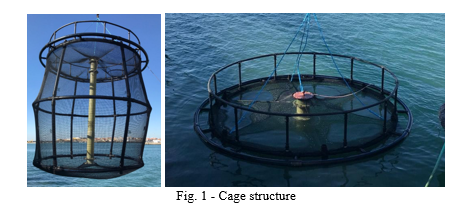PILOT CAGE FOR OFFSHORE FISH FARMING
Introduction
The necessity for aquaculture to sustainably feed the world’s growing population with a healthy protein, in a responsible manner, is well accepted and understood in government and academic circles. The Portuguese offshore has particularities that have to be taken into account and technically resolved, namely with regard to the vigorous marine swell on the West Portuguese Atlantic coast. Significant technological advances are needed in order to develop sustainable technical solutions from a structural point of view, capable of providing the national aquaculture industry with oceanic cages that allow the establishment of a stable and competitive production base on a global level.
This work intends to contribute to this effort by providing a cage prototype that, after further improvements, is expected to boost the Portuguese aquaculture sector. Many different cage designs and models have been developed and a few are commercially available. Various parameters, like site location/exposure, mooring system, environmental conditions, affect the well-being of culture fish and farm performance. Nevertheless, geometry/shape, size, construction materials and proper design are critical for cage performance, especially on rough sea conditions. High-density polyethylene (HDPE) has been widely used because of its versatility, resistance and low cost. In this work, HDPE tube was also used as main structural material, covered by a nylon net for fish stabling, and a central tube aiming to control the up and down movement of the cage on the water column.
Materials & Methods
The effect of different forces on the performance of the developed cage was assessed by using models for dimensioning the cage considering two main types of forces: static forces as self-weight and hydrostatic pressure and hydrodynamic forces as drag, current and wave forces. Wind forces were not taken into consideration since the cage is submerged.1,2 The sizing model considers its position relative to water level, up to 30 m depth. These models were developed according with DNV3. The dimensioning was performed on Abaqus software.
Cage structure was manufactured using HDPE tube (200 mm of diameter) connected to a central tube made of fiberglass (500 mm of diameter) that ensures the movement of descending and ascending the cage. HDPE tubes were assembled using a standard welding processes, forming a tubular structure that is connected by steel cables to the central fiberglass tube.
Results & Discussion
The cage concept (fig. 1) was designed and developed to meet challenges identified by aquaculture, such as autonomy, maintenance and robustness. The cage incorporates a up and down movement system that allows it to be placed safely, if rough wave conditions arise, for its structural resistance and for the healthy development of the fish. The cage is characterised by an external tubular structure where the net that allows the stabling of the fish is fixed and connected to a central tube. Details regarding geometry, materials and construction methodologies used are provided.
The external tubular structure is circular in its water plane and rounded in depth, allowing greater efficiency in the space for fish to swim in circular patterns4. Other reason for this type of geometry was the better resistance to stresses when installed in different locations, as often occur at Peniche (wave height of 7 m and average period of 11 sec: IPMA, 2018). The structure was manufactured with HDPE tubes, a material with good energy absorption capacity that makes it interesting for applications subject to fatigue conditions.
The central tube is expected to accommodate different cage functional systems for autonomous operation, such as the automatic feeder, monitoring system, batteries and the up and down movement system of the cage. This component was designed in composite material to incorporate systems that require greater robustness.
This work was supported by Fundo Europeu dos Assuntos Marítimos e das Pescas (FEAMP) through the Operational Programme Mar2020. The authors acknowledge Mar2020 for financial support (grant number: 16-02-01-FMP-0041). Abilio Ferreira gratefully acknowledges support from Mar2020 for a research fellowship. The authors have no competing interests to declare.
1. Ágústsson G. Design considerations and loads on open ocean fish cages south of Iceland. Univ Icel. 2004;(June).
2. Moe H, Fredheim A, Hopperstad OS. Structural analysis of aquaculture net cages in current. J Fluids Struct. 2010;26(3):503-516. doi:10.1016/j.jfluidstructs.2010.01.007
3. Kovacs G. Environmental conditions and environmental testing. INTELEC, Int Telecommun Energy Conf. 1993;2(October):92-99. doi:10.1109/INTLEC.1993.388591
4. Kumar V. Engineering consideration for cage aquaculture. IOSR J Eng. 2014;4(6):11-18. doi:10.9790/3021-04661118
